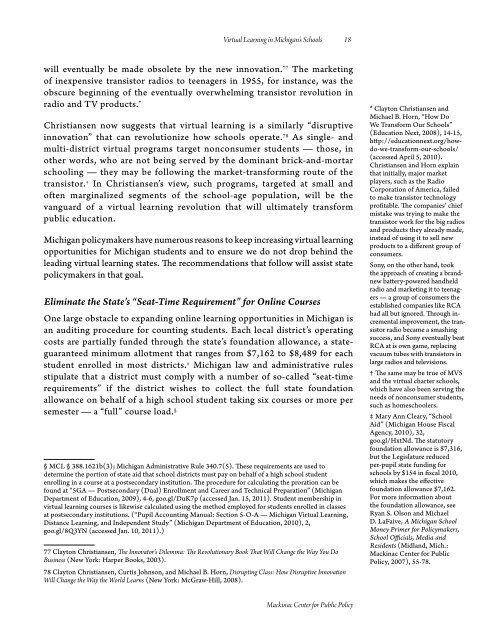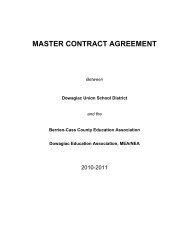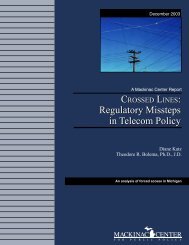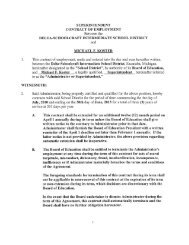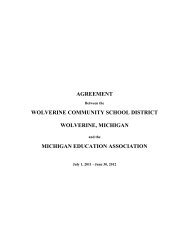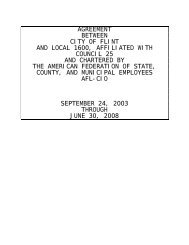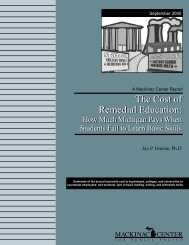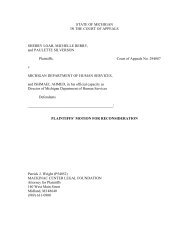by Michael Van Beek - Michigan Virtual University
by Michael Van Beek - Michigan Virtual University
by Michael Van Beek - Michigan Virtual University
Create successful ePaper yourself
Turn your PDF publications into a flip-book with our unique Google optimized e-Paper software.
<strong>Virtual</strong> Learning in <strong>Michigan</strong>’s Schools 18will eventually be made obsolete <strong>by</strong> the new innovation. 77 The marketingof inexpensive transistor radios to teenagers in 1955, for instance, was theobscure beginning of the eventually overwhelming transistor revolution inradio and TV products.*Christiansen now suggests that virtual learning is a similarly “disruptiveinnovation” that can revolutionize how schools operate. 78 As single- andmulti-district virtual programs target nonconsumer students — those, inother words, who are not being served <strong>by</strong> the dominant brick-and-mortarschooling — they may be following the market-transforming route of thetransistor. † In Christiansen’s view, such programs, targeted at small andoften marginalized segments of the school-age population, will be thevanguard of a virtual learning revolution that will ultimately transformpublic education.<strong>Michigan</strong> policymakers have numerous reasons to keep increasing virtual learningopportunities for <strong>Michigan</strong> students and to ensure we do not drop behind theleading virtual learning states. The recommendations that follow will assist statepolicymakers in that goal.Eliminate the State’s “Seat-Time Requirement” for Online CoursesOne large obstacle to expanding online learning opportunities in <strong>Michigan</strong> isan auditing procedure for counting students. Each local district’s operatingcosts are partially funded through the state’s foundation allowance, a stateguaranteedminimum allotment that ranges from $7,162 to $8,489 for eachstudent enrolled in most districts. ‡ <strong>Michigan</strong> law and administrative rulesstipulate that a district must comply with a number of so-called “seat-timerequirements” if the district wishes to collect the full state foundationallowance on behalf of a high school student taking six courses or more persemester — a “full” course load. §§ MCL § 388.1621b(3); <strong>Michigan</strong> Administrative Rule 340.7(5). These requirements are used todetermine the portion of state aid that school districts must pay on behalf of a high school studentenrolling in a course at a postsecondary institution. The procedure for calculating the proration can befound at “5GA — Postsecondary (Dual) Enrollment and Career and Technical Preparation” (<strong>Michigan</strong>Department of Education, 2009), 4-6, goo.gl/DuK7p (accessed Jan. 15, 2011). Student membership invirtual learning courses is likewise calculated using the method employed for students enrolled in classesat postsecondary institutions. (“Pupil Accounting Manual: Section 5-O-A — <strong>Michigan</strong> <strong>Virtual</strong> Learning,Distance Learning, and Independent Study” (<strong>Michigan</strong> Department of Education, 2010), 2,goo.gl/8Q3YN (accessed Jan. 10, 2011).)77 Clayton Christiansen, The Innovator’s Dilemma: The Revolutionary Book That Will Change the Way You DoBusiness (New York: Harper Books, 2003).78 Clayton Christiansen, Curtis Johnson, and <strong>Michael</strong> B. Horn, Disrupting Class: How Disruptive InnovationWill Change the Way the World Learns (New York: McGraw-Hill, 2008).* Clayton Christiansen and<strong>Michael</strong> B. Horn, “How DoWe Transform Our Schools”(Education Next, 2008), 14-15,http://educationnext.org/howdo-we-transform-our-schools/(accessed April 5, 2010).Christiansen and Horn explainthat initially, major marketplayers, such as the RadioCorporation of America, failedto make transistor technologyprofitable. The companies’ chiefmistake was trying to make thetransistor work for the big radiosand products they already made,instead of using it to sell newproducts to a different group ofconsumers.Sony, on the other hand, tookthe approach of creating a brandnewbattery-powered handheldradio and marketing it to teenagers— a group of consumers theestablished companies like RCAhad all but ignored. Through incrementalimprovement, the transistorradio became a smashingsuccess, and Sony eventually beatRCA at is own game, replacingvacuum tubes with transistors inlarge radios and televisions.† The same may be true of MVSand the virtual charter schools,which have also been serving theneeds of nonconsumer students,such as homeschoolers.‡ Mary Ann Cleary, “SchoolAid” (<strong>Michigan</strong> House FiscalAgency, 2010), 32,goo.gl/HxtNd. The statutoryfoundation allowance is $7,316,but the Legislature reducedper-pupil state funding forschools <strong>by</strong> $154 in fiscal 2010,which makes the effectivefoundation allowance $7,162.For more information aboutthe foundation allowance, seeRyan S. Olson and <strong>Michael</strong>D. LaFaive, A <strong>Michigan</strong> SchoolMoney Primer for Policymakers,School Officials, Media andResidents (Midland, Mich.:Mackinac Center for PublicPolicy, 2007), 55-78.Mackinac Center for Public Policy


